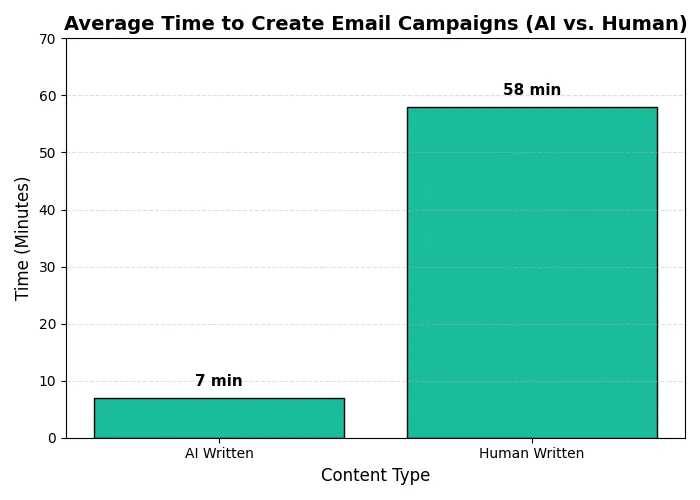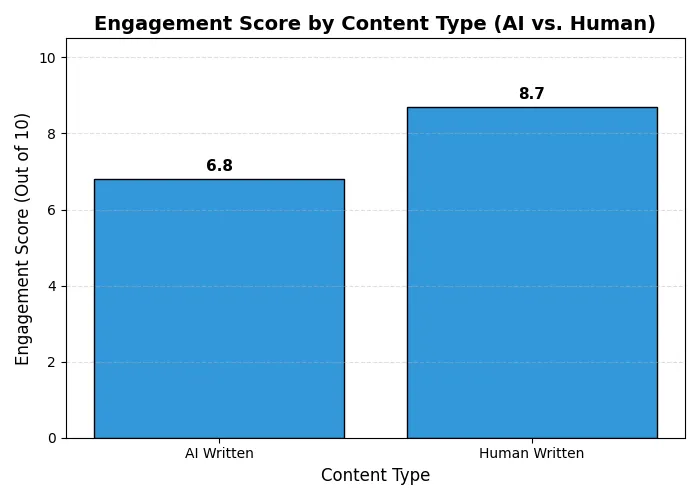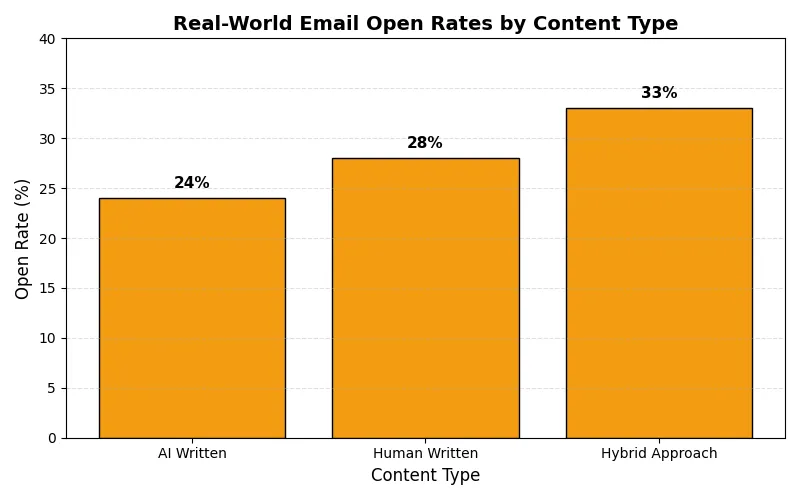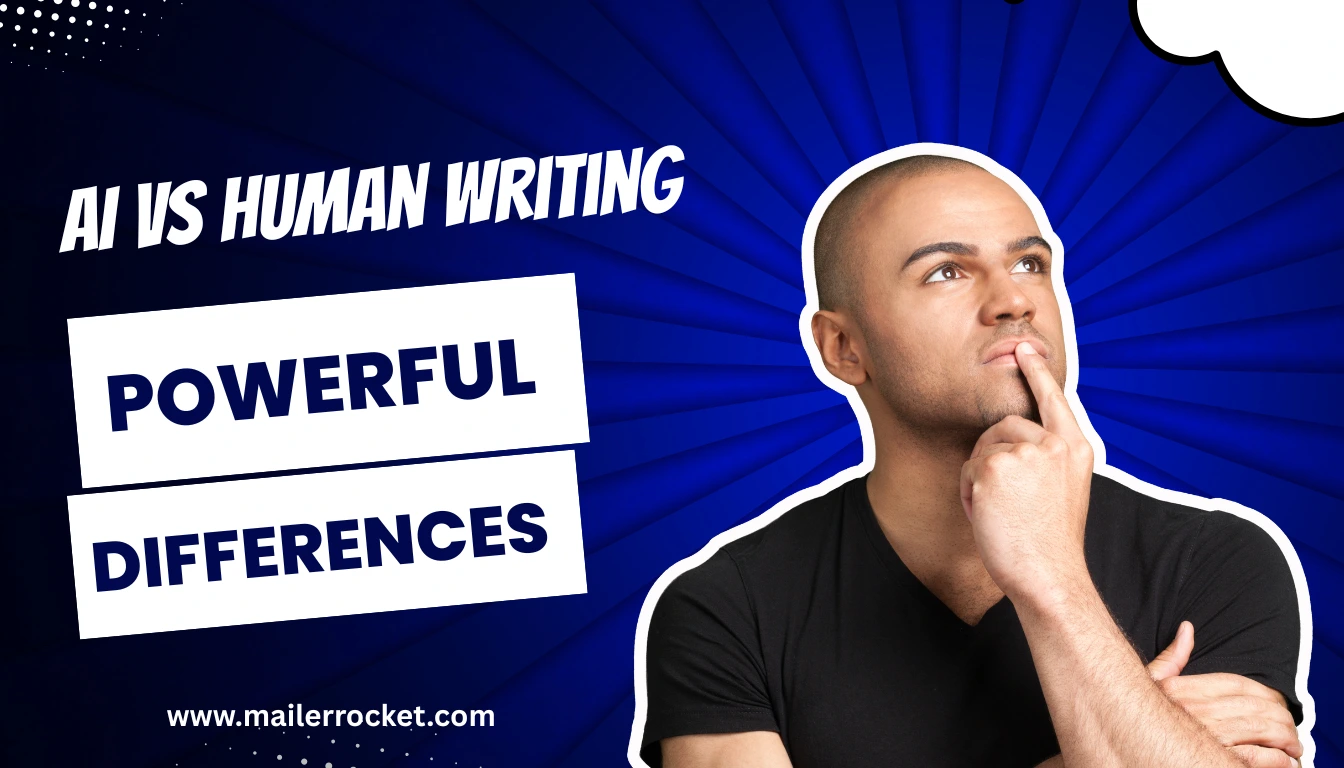The rise of artificial intelligence in content creation has sparked anxiety among human writers. Advanced tools can now produce unique, well-researched content in seconds, from articles to social media posts. This rapid output challenges the traditional role of human creativity and craftsmanship. Many writers fear being replaced, while others see AI as a powerful assistant rather than a threat.
This shift has significant implications for email marketing, where the line between AI-generated and human-written content is becoming increasingly blurred. As content creators, we’re left wondering: can machines truly replace the nuance and creativity of human writers? The answer may lie not in replacement, but in collaboration—leveraging the strengths of both to produce more impactful content.
Key Takeaways
- The role of artificial intelligence in content creation is expanding.
- Human writers are feeling the pressure due to AI’s capabilities.
- Email marketing is a key area where AI vs. human writing are being compared.
- The differences between AI-generated and human-written content are significant.
- Understanding these differences is crucial for effective content creation.
Supercharge Your AI Email Strategy with MailerRocket
Take your email campaigns to the next level using AI-powered tools that ensure higher inbox placement, automation, and deep personalization. MailerRocket is built to help you scale with confidence—faster, smarter, better.
The Evolution of Email Marketing Content Creation
Email marketing content creation has undergone a major transformation—from labor-intensive manual copywriting to smart, AI-assisted workflows. In the past, marketers had to craft every email by hand, often relying on intuition and trial-and-error to guess what might resonate with their audience. Today, AI tools analyze user behavior, engagement patterns, and preferences to generate personalized content at scale. This shift has significantly improved efficiency, enabling faster campaign execution while ensuring messages are highly relevant to each recipient.
Beyond speed and automation, AI has introduced a new level of sophistication to email marketing. From predictive subject lines and dynamic content blocks to optimized send times and real-time A/B testing, AI empowers marketers to make data-driven decisions that boost open rates and conversions. This evolution not only streamlines campaign management but also enhances customer engagement by delivering the right message to the right person at the right time—making email marketing more effective, personalized, and impactful than ever before.
From Manual Copywriting to AI Assistance
Traditionally, email marketing relied heavily on human copywriters to craft messages. However, with the advent of artificial intelligence (AI) and machine learning, the process has become more streamlined. AI-powered tools are now capable of analyzing vast amounts of data to create highly personalized content. These tools can automatically segment audiences, predict user behavior, and tailor messages for maximum engagement. As a result, marketers can launch smarter, data-driven campaigns with greater speed and efficiency.

The Current State of Email Marketing Technology
Today, email marketing technology is more sophisticated than ever. Tools like ChatGPT are revolutionizing content creation by generating high-quality content in real-time. This not only saves time but also enhances the personalization and engagement of email campaigns. Marketers can now test multiple variations instantly, refining messages based on real-time performance data. As a result, campaigns become more adaptive, impactful, and aligned with audience preferences.
The integration of AI in email marketing is a game-changer, offering marketers the ability to scale their efforts while maintaining a high level of personal touch.
AI vs. Human Writing: Core Fundamentals Explained
To truly appreciate the differences between AI and human writing, it’s important to understand how each approach functions at its core. AI writing relies on machine learning algorithms, natural language processing (NLP), and vast datasets to generate content that mimics human language. These systems are trained on millions of text samples, allowing them to recognize patterns, predict word sequences, and create grammatically sound content almost instantly. This makes AI ideal for generating large volumes of content quickly, maintaining consistency, and scaling personalized email campaigns with minimal manual effort.
On the other hand, human writing draws from lived experience, emotional intelligence, and creativity—qualities that AI still struggles to replicate authentically. Human writers bring unique tone, brand voice, storytelling, and cultural awareness into their content, often leading to deeper audience connections and more nuanced messaging. While AI excels in speed and data-driven personalization, humans excel in crafting messages that resonate emotionally and feel genuine. In email marketing, the most effective campaigns often blend both approaches—using AI for structure and scale, and human insight for warmth, relatability, and brand alignment.
Here’s a side-by-side comparison to highlight the key differences and strengths of AI vs. human writing. This table offers a clearer perspective on how each contributes uniquely to email marketing success.
| Aspect | AI Writing | Human Writing |
|---|---|---|
| Speed | Generates content in seconds | Takes longer due to thoughtful crafting |
| Scalability | Easily scales to thousands of emails | Limited by writer capacity and time |
| Tone and Emotion | Can mimic tone, but lacks genuine emotional depth | Naturally conveys emotions and empathy |
| Creativity | Pattern-based, often lacks original thought | Imaginative, capable of storytelling and unique angles |
| Consistency | Maintains uniform style and structure effortlessly | May vary across writers or campaigns |
| Cultural Sensitivity | Limited unless specifically trained | Understands context, culture, and social nuance |
| Adaptability | Adapts based on data and algorithm training | Adapts through intuition and human feedback |
| Ideal Use Case | High-volume, data-driven, personalized campaigns | Brand-building, emotional storytelling, and creative strategy |
How AI Writing Technology Works
AI systems create content by processing massive datasets, identifying patterns, and applying structured algorithms to generate sentences, paragraphs, and even entire articles. This process is facilitated by natural language processing (NLP), a technology that enables computers to understand, interpret, and generate human language. AI writing tools can analyze vast amounts of data quickly, learn from it, and produce content that is coherent and contextually relevant.
The efficiency of AI writing technology lies in its ability to automate repetitive tasks, such as data-driven content creation, allowing marketers to focus on more strategic aspects of their campaigns. However, the quality and relevance of AI-generated content depend heavily on the data it is trained on and the algorithms used.
Boost Brand Trust & Open Rates by 40%—Switch to MailerRocket Now!
The Human Element in Copywriting
Human writers bring a unique perspective and creativity to copywriting, leveraging their understanding of emotional nuances and brand voices to craft compelling narratives. Unlike AI, humans can intuitively understand the subtleties of language, tone, and context, enabling them to create content that resonates with audiences on a deeper level.
The human element in copywriting is characterized by the ability to adapt to complex brand guidelines, understand the emotional undertones of a message, and inject creativity into the content. Human writers can also empathize with the target audience, tailoring the message to evoke the desired response.
Key Distinctions in Approach and Methodology
The primary distinction between AI vs. human writing lies in their approach to content creation. AI relies on data analysis and algorithms, while humans depend on creativity, intuition, and emotional understanding. This fundamental difference impacts the type of content produced, its relevance, and its ability to engage the target audience.
- AI writing excels in efficiency, scalability, and data-driven content creation.
- Human writing offers creativity, emotional resonance, and a nuanced understanding of brand voice and audience needs.
Understanding these core fundamentals is crucial for marketers aiming to leverage the strengths of both AI vs. human writing in their email campaigns.
Difference #1: Personalization and Emotional Connection
The first major difference between AI vs. human writing in email campaigns is the approach to personalization and creating an emotional resonance with the reader. While both AI vs. human writers aim to craft compelling email content, their methods and outcomes differ significantly in terms of personalization and emotional connection. AI uses data and behavioral patterns to personalize messages at scale, often relying on algorithms to predict what will engage a user. In contrast, human writers use empathy, intuition, and storytelling to forge genuine, emotionally driven connections with the audience.

AI’s Approach to Personalization
AI systems leverage vast amounts of customer data to personalize email content. By analyzing past interactions, purchase history, and browsing behavior, AI can tailor messages that are likely to resonate with individual recipients. For instance, AI can dynamically insert the recipient’s name, reference their past purchases, or suggest products based on their browsing history. However, AI’s personalization is limited to patterns and data analysis, which may not always capture the nuances of human emotion or the context of individual preferences.
The Human Touch in Creating Emotional Resonance
Human writers, on the other hand, bring a level of emotional understanding and empathy to their writing that AI systems currently cannot match. They can craft narratives that evoke emotions, create a sense of connection, and tailor the tone to suit the audience’s mood and preferences. Human writers can also incorporate subtle humor, empathy, and other emotional cues that make the content more relatable and engaging. This human touch is particularly valuable in creating emotional resonance, which is crucial for building brand loyalty and driving customer engagement.
Case Study: Emotional Appeals in Successful Email Campaigns
A notable example of successful emotional appeal in email marketing is the “Share a Coke” campaign by Coca-Cola. By personalizing bottles with popular names and encouraging customers to share a Coke with friends or family, Coca-Cola created a campaign that was both personal and emotionally engaging. The campaign’s success was largely due to its ability to tap into the nostalgia and joy associated with sharing a Coke, demonstrating the power of emotional connection in marketing.
In conclusion, while AI excels at data-driven personalization, human writers have a unique ability to craft emotionally resonant content. The most effective email marketing strategies may therefore involve a combination of AI’s analytical capabilities and human creativity to achieve both personalization and emotional connection.
Difference #2: Efficiency and Scalability
In the fast-paced world of email marketing, the ability to produce content efficiently and scale it effectively has become essential. As competition intensifies and consumer attention spans shrink, businesses can no longer afford slow or inconsistent messaging. Manual content creation processes often fall short in meeting the speed and volume required to stay relevant. This is where scalable email marketing solutions, especially those powered by AI, play a crucial role. They enable marketers to generate high-quality, personalized emails in seconds, streamline campaign execution, and maintain consistency across large audiences. By adopting intelligent automation tools, businesses can stay agile, competitive, and better positioned to meet evolving customer expectations.

AI’s Speed and Volume Capabilities
AI-powered writing tools have revolutionized the way businesses approach email marketing. With the ability to generate vast amounts of content quickly, these tools are perfect for companies that need consistent and rapid output. They streamline the creation process, saving valuable time and resources. For example, AI can produce multiple variations of an email campaign in just seconds. This level of speed and scalability is nearly impossible to achieve with manual writing alone. As a result, marketers can focus more on strategy and less on repetitive content creation.
Human Writing Workflow and Limitations
While AI excels in speed and volume, human writers bring essential creativity and nuance to email marketing content. Their ability to craft emotionally resonant messages adds depth that AI often lacks. However, human writing is time-consuming and limited by the availability of skilled talent. As marketing demands increase, scaling human-led content creation becomes a major challenge. This makes balancing both approaches increasingly important for effective campaigns.
Cost-Benefit Analysis of Both Approaches
A cost-benefit analysis of AI versus human writing for email marketing reveals interesting insights. While AI tools require initial investment in technology and training, they offer long-term savings through reduced labor costs and increased productivity. On the other hand, human writers, though more expensive in the long run, bring a unique perspective and emotional resonance that can be critical to campaign success.
- AI writing tools offer speed and scalability, ideal for large-scale email campaigns.
- Human writers provide creativity and emotional connection, crucial for campaign effectiveness.
- The choice between AI vs. human writing depends on specific business needs and goals.
Ultimately, understanding the differences in efficiency and scalability between AI vs. human writing is key to making informed decisions in email marketing strategies.
Difference #3: Creativity and Originality
The third key difference between AI and human writing lies in their approaches to creativity and originality in email marketing. While AI has advanced in generating structured and relevant content, it often lacks the depth of imagination and emotional resonance that human writers provide. Human creativity stems from experience, intuition, and storytelling—elements that are difficult for machines to mimic authentically. This distinction becomes especially important when crafting brand voice and emotionally driven campaigns. The table below highlights this contrast clearly:
| Aspect | AI Writing | Human Writing |
|---|---|---|
| Creativity | Pattern-based, limited originality | Intuitive, emotionally driven |
| Speed | Extremely fast | Moderate to slow |
| Consistency | High, algorithmically maintained | Variable, depends on writer |
| Emotional Impact | Often lacks depth | Strong and relatable |
| Brand Adaptability | Needs training data | Naturally aligns with brand tone |

AI’s Creative Limitations and Strengths
AI systems are excellent at analyzing data and generating content based on patterns. However, their creativity is limited by the data they’ve been trained on. AI can produce variations of existing ideas but often struggle to create entirely new concepts. On the other hand, AI’s strength lies in its ability to process vast amounts of data quickly, providing insights that can inform creative decisions.
Human Innovation in Email Copy
Human writers bring a level of creativity and originality that AI currently cannot match. Human innovation in email copy often involves intuitive leaps and understanding of nuanced audience needs. Humans can craft narratives, evoke emotions, and create a personal connection with the reader in ways that AI is still learning to replicate. This human touch can be the differentiator that turns a generic message into a memorable experience.
Examples of Breakthrough Email Campaigns
- Campaigns that use storytelling to connect with the audience on an emotional level.
- Personalized emails that address the recipient by name and tailor content based on their preferences.
- Innovative use of interactive elements, such as quizzes or gamification, to enhance engagement.
| Aspect | AI Strengths | Human Strengths |
|---|---|---|
| Creativity | Data-driven insights, pattern recognition | Innovative ideas, emotional connection |
| Originality | Variations of existing concepts | New concepts, nuanced understanding |
Upgrade to MailerRocket & Experience AI + Human Efficiency
Combine powerful AI writing tools with seamless email delivery performance. MailerRocket offers unbeatable pricing, spam-bypass features, and deep integration with your favorite marketing systems.
Difference #4: Adaptability to Audience Feedback
The ability to adapt to audience feedback is a key differentiator between AI and human writing in email campaigns. This adaptability plays a critical role in the overall success of email marketing, as it enables marketers to fine-tune their messaging strategies based on real-time data, user behavior, and campaign performance metrics. AI excels at processing large volumes of engagement data quickly, automatically optimizing subject lines, send times, and even content layouts for better results. However, human writers bring contextual understanding and emotional intelligence to the table, allowing them to interpret subtle audience cues and adjust tone, storytelling, or messaging in ways AI cannot. Together, both approaches enhance the responsiveness and relevance of email marketing efforts.
How AI Learns From Performance Metrics
AI systems can analyze vast amounts of data from email campaigns, including open rates, click-through rates, and conversion rates. By leveraging this data, AI can adjust email content and targeting strategies to better resonate with the audience. For instance, AI can analyze user data and create personalized recommendations or emails tailored to individual preferences. This level of automation allows marketers to scale personalization efforts without compromising efficiency. As a result, campaigns become more data-driven, relevant, and performance-focused.
Human Writers’ Intuitive Adaptation
Human writers bring an intuitive and emotionally aware understanding to adapting to audience feedback. Unlike AI, which relies strictly on data patterns, humans can interpret subtle cues such as tone shifts, cultural context, or changing audience sentiment. They can adjust their writing style not just for clarity but to resonate more deeply with the reader. Human writers also creatively incorporate feedback, often going beyond what analytics alone would suggest. This allows for more thoughtful, personalized, and emotionally impactful communication in email marketing.
Measuring Responsiveness to Campaign Results
To measure the effectiveness of adaptability in email campaigns, marketers can track key performance indicators (KPIs) such as:
- Open rates
- Click-through rates
- Conversion rates
- Unsubscribe rates
By analyzing these KPIs, marketers can determine whether their AI or human-written email campaigns are successfully adapting to audience feedback.
In conclusion, both AI vs. human writing have unique strengths when it comes to adapting to audience feedback. While AI excels at analyzing large datasets, human writers bring a creative and intuitive approach to interpreting feedback.
Boost Brand Trust & Open Rates by 40%—Switch to MailerRocket Now!
Difference #5: Brand Voice Consistency
Consistency in brand voice is not just a nicety, but a necessity in email marketing, where AI vs. human writing intersect. Maintaining a uniform tone and style across email campaigns is crucial for reinforcing brand identity and building trust with subscribers. While AI can be trained to replicate a brand’s tone, it still requires human oversight to ensure authenticity and emotional relevance. A consistent voice helps create a cohesive experience that strengthens customer relationships over time.
AI’s Ability to Maintain Consistent Messaging
AI-generated emails have the advantage of maintaining a consistent tone and style across large volumes of content. This is particularly beneficial for factual content that requires accuracy and uniformity. AI email marketing tools can be programmed to adhere to specific brand guidelines, ensuring that the messaging remains consistent across different campaigns and over time. This consistency builds brand trust and reduces the chances of off-brand communication. Moreover, AI tools can instantly adapt templates to match tone preferences across multiple audience segments.
Here’s a table summarizing the benefits of AI in maintaining consistency:
| Feature | AI Strength | Benefit for Email Marketing |
|---|---|---|
| Tone & Style Consistency | Programmed tone, uniform language | Maintains cohesive brand identity |
| Brand Guideline Compliance | Follows pre-set templates and rules | Reduces risk of off-brand messaging |
| High-Volume Scalability | Repeats style across thousands of emails | Ensures consistent quality across campaigns |
| Factual Accuracy | Pulls from verified data and templates | Ideal for newsletters, updates, and promotions |
| Segment-Specific Adaptability | Adjusts tone slightly for different audience groups | Personalization with consistency |
Human Variability in Voice and Tone
Human writers, on the other hand, bring variability to the content they create. While this can sometimes result in inconsistencies in brand voice, it also allows for creativity and adaptation to different contexts. Human intuition plays a significant role in adjusting the tone and style to suit the audience and purpose of the email campaign. This flexibility enables more personalized and emotionally engaging messaging that resonates on a deeper level.
Strategies for Brand Alignment in Email Marketing
To achieve brand voice consistency, marketers can employ several strategies:
- Develop clear brand guidelines that outline the tone, style, and language to be used in email marketing.
- Use AI tools to generate content that adheres to these guidelines, ensuring consistency across campaigns.
- Have human writers review and adjust AI-generated content to inject creativity and emotional resonance while maintaining brand alignment.
By combining the strengths of AI vs. human writing, brands can achieve a consistent voice that resonates with their audience.
Top AI Tools Transforming Email Marketing Today
Businesses are increasingly leveraging AI-powered tools to elevate their email marketing strategies and improve campaign performance. The use of AI in email marketing is not just a trend; it’s becoming a standard practice for businesses looking to enhance their customer engagement and conversion rates. AI enables real-time personalization, automated optimization, and insightful analytics that drive smarter decisions. As a result, companies can deliver more relevant content, boost ROI, and stay ahead in a competitive digital landscape.
Leading AI Writing Platforms for Email Campaigns
Several AI writing platforms have emerged as leaders in the email marketing space. These platforms use advanced algorithms to generate high-quality email content, including product descriptions and promotional emails. Some of the top platforms include:
- AI Writer: Known for its ability to create engaging email content quickly.
- Copy.ai: Utilizes AI to produce creative and effective email copy.
- MailerRocket – Designed specifically for email marketers, MailerRocket helps creators and affiliate marketers craft deliverability-optimized campaigns with AI-powered subject lines, smart segmentation, and built-in spam filter protection.
- ZplusAI – Available here, ZplusAI empowers users with tools to generate emails, ads, and visuals instantly using advanced AI models, making it a versatile option for multi-channel marketing.
Integration Capabilities with Email Marketing Systems
One of the key considerations when selecting an AI tool for email marketing is its ability to integrate with existing email marketing systems. Most leading AI writing platforms offer seamless integration with popular email marketing software, allowing businesses to automate their email campaigns efficiently.
| AI Platform | Integration Capabilities | Pricing Model |
|---|---|---|
| AI Writer | Mailchimp, Constant Contact | Subscription-based |
| EmailGenesis | HubSpot, Marketo | Pay-per-use |
| Copy.ai | Mailchimp, Salesforce | Freemium model |
Pricing and Accessibility Considerations
Pricing is a critical factor for businesses when adopting AI tools for email marketing. The cost can vary significantly depending on the platform and its features. Some platforms offer a freemium model, while others charge based on usage or subscription. Businesses need to assess their budget and choose a tool that offers the best value for their needs.
By understanding the capabilities and pricing of these AI tools, businesses can make informed decisions about which tools to adopt for their email marketing campaigns.
Real-World Performance: Open Rates and Conversion Metrics
Analyzing real-world email campaign data reveals crucial insights into the performance of AI vs. human writing content. By examining key metrics such as open rates, click-through rates, and conversion rates, marketers can better understand which approach delivers stronger engagement and ROI. Studies have shown that while AI-generated emails often excel in efficiency and consistency—especially in large-scale campaigns—human-written content tends to perform better when emotional connection and storytelling are critical. Additionally, hybrid strategies that incorporate AI-generated structure with human-crafted enhancements often yield the most balanced and effective results. This data-driven evaluation empowers marketers to refine their strategies based on actual audience behavior and campaign outcomes.

Comparative Studies on Email Campaign Performance
Several studies have compared the performance of AI-generated email content with that created by humans. For instance, a study found that human-written emails tend to have higher engagement rates, including open rates and click-through rates, compared to their AI-generated counterparts. However, AI email copy performance has shown remarkable improvements in recent years, with some AI tools achieving open rates and conversion rates comparable to those of human-written emails.
According to a report by Marketing Profs, emails with personalized content, often generated using AI, saw a significant boost in open rates and conversion rates. This suggests that while human-written content excels in emotional resonance, AI’s ability to personalize content at scale is a powerful tool in email marketing.
What the Data Reveals About Reader Preferences
The data from various studies indicate that reader preferences lean towards content that is not only personalized but also engaging and relevant. Human-written email marketing content tends to perform well in terms of emotional connection, while AI-generated content excels in scalability and efficiency. Striking the right balance between both approaches can lead to significantly improved campaign outcomes and audience satisfaction.
Industry-Specific Performance Variations
It’s also important to note that performance can vary significantly across different industries. For example, in the e-commerce sector, AI-generated emails have been shown to perform well in terms of conversion rates due to their ability to be highly targeted. In contrast, human-written content may be more effective in industries where the message needs to convey complex emotions or nuanced ideas.
“The key to success lies in understanding your audience and choosing the right tool for the job,” says a marketing expert. This highlights the importance of a hybrid approach, combining the strengths of both AI vs. human writing to achieve optimal results in email marketing campaigns.
In conclusion, while human-written content tends to have an edge in terms of engagement, AI-generated content is rapidly closing the gap, especially when it comes to personalization and scalability. By understanding the strengths and weaknesses of each approach, marketers can make informed decisions to improve their email marketing strategies.
Implementing a Hybrid Approach: Best Practices
A hybrid strategy, blending the strengths of AI vs. human writing, can significantly enhance email marketing effectiveness. By combining the efficiency of AI with the creativity of human writers, marketers can create compelling email campaigns that resonate with their audience. This approach leverages automation for scale while preserving emotional depth and authenticity. Ultimately, it enables businesses to deliver consistent, high-performing content tailored to individual needs.
Here’s a table illustrating the benefits of a hybrid strategy:
| Feature | AI Contribution | Human Contribution | Hybrid Benefit |
|---|---|---|---|
| Content Generation | Fast, high-volume output | Creative, emotionally resonant writing | Scalable yet engaging content |
| Personalization | Data-driven, behavioral targeting | Contextual and cultural understanding | Deeply relevant and humanized personalization |
| Tone and Brand Voice | Consistent with training | Intuitive and adaptable | Authentic and cohesive brand communication |
| A/B Testing & Optimization | Real-time analysis and adaptation | Strategic insights based on experience | Continuous improvement with strategic depth |
| Campaign Scalability | Automation for large lists | Tailored messages for key segments | Efficient scaling without losing relevance |
AI-Assisted Human Writing Workflows
AI can assist human writers in various ways, such as generating initial drafts, suggesting alternative phrases, and optimizing content for better engagement. This collaboration allows human writers to focus on high-level creative decisions while AI handles more mundane tasks.
- AI can analyze data to suggest personalized content for different segments of the audience.
- Human writers can then refine this content to ensure it meets the brand’s tone and style guidelines.
- The result is a highly personalized and engaging email campaign that leverages the strengths of both AI vs. human writing.
Effective Division of Labor Between AI and Humans
The key to a successful hybrid approach is determining the optimal division of labor between AI vs. human writing. AI excels at tasks that require data analysis, pattern recognition, and scalability, such as generating product descriptions or personalized recommendations.
Humans, on the other hand, bring creativity, empathy, and emotional understanding to the table, making them ideal for crafting compelling narratives and ensuring brand consistency.
Step-by-Step Implementation Guide for Marketing Teams
- Assess your current email marketing workflow and identify areas where AI can assist human writers.
- Select an AI writing tool that integrates with your existing email marketing platform.
- Train your AI tool on your brand’s existing content to ensure consistency in tone and style.
- Implement a feedback loop where human writers can review and refine AI-generated content.
- Continuously monitor the performance of your email campaigns and adjust your hybrid approach as needed.
By following these steps and embracing a hybrid approach, marketing teams can create more effective email marketing campaigns that leverage the strengths of both AI vs. human writing.
Boost Brand Trust & Open Rates by 40%—Switch to MailerRocket Now!
Conclusion: The Future of Email Marketing in the AI Era
As AI technology continues to evolve, it is likely to play an increasingly significant role in email marketing content creation. The comparison between AI-generated and human-written content has revealed key differences that can inform email marketing strategies. By understanding the strengths and limitations of both AI and human writers, marketers can create more effective campaigns.
The future of email marketing in the AI era will be characterized by increased personalization, efficiency, and creativity. AI will enable marketers to analyze vast amounts of data, tailor their content to specific audience segments, and optimize their email marketing strategy for better performance. Human writers will continue to play a crucial role in creating emotional resonance and original content that resonates with readers.
By adopting a hybrid approach that combines the strengths of AI vs. human writers, marketers can create email campaigns that drive engagement and conversion. As the AI era continues to unfold, it is essential for marketers to stay ahead of the curve and leverage the latest advancements in AI technology to inform their content creation and email marketing strategy.
You can have an opportunity to receive extra $37k + Bonuses if you finish 2 steps below:
- Step 1- Get MailerRocket by Clicking Here
- Step 2- You will get ALL my Exclusive Cloud-Based Software Bonuses listed below!
These bonuses are hand-picked to supercharge your MailerRocket experience — including tools for lead generation, traffic, analytics, and conversion! IMPORTANT: After completing your order, don’t forget to email me at admin@mailerrocket.com with your purchase receipt or confirmation screenshot.
Bonus 1 – The Sales Lead System Guide
Unlock the full potential of your business with this exclusive Sales Lead System Guide.
Learn proven techniques to attract, nurture, and convert high-quality leads effectively.
Discover step-by-step strategies for building powerful lead funnels that actually work.
Master lead scoring, segmentation, and automation to save time and boost conversions.
Get insights into top-performing tools, scripts, and templates used by sales pros.
Ideal for marketers, entrepreneurs, and sales teams looking to scale fast.
Includes bonus checklists and lead magnet ideas to supercharge your outreach.
Turn cold prospects into loyal customers with this easy-to-follow lead generation blueprint.

Bonus 2 – 500 Digital Product Business Ideas
Unlock a treasure trove of 500 profitable digital product ideas for any niche.
From eBooks to online courses, printables to templates — endless inspiration awaits.
Perfect for creators, freelancers, marketers, and aspiring solopreneurs.
Ideas categorized by skill level, industry, and target audience.
Includes trends for 2025 and beyond — stay ahead of the curve.
Each idea is designed for low-cost, high-margin digital delivery.
Discover ideas that scale, automate, and generate passive income.
Includes bonus tips for pricing, platforms, and marketing.
Ideal for Etsy, Gumroad, Shopify, ClickBank, and more.
Save time on brainstorming — launch faster with clarity.
Whether you want side income or a full-time digital empire — this is your guide.
Turn your creativity into cash with these powerful product ideas!

Bonus 3 – 1 Million Youtube Subscribers Free
1 Million YouTube Subscribers Free – sounds like a dream come true for any aspiring content creator, right? This bonus is designed to unlock the secrets behind explosive YouTube growth without paying for ads or using shady bots. Whether you’re starting a channel or struggling to gain momentum, this bonus guide reveals proven strategies used by top influencers to organically build a massive audience. From mastering the YouTube algorithm to crafting irresistible thumbnails and titles that drive clicks, it covers every step needed to attract real, engaged subscribers who stick around.
Inside this bonus, you’ll also discover how to turn viewers into loyal fans using powerful storytelling techniques and content hooks that keep people watching and sharing. Learn how to leverage trending topics, use data analytics to optimize your content calendar, and tap into community engagement features to boost visibility. With practical tips, templates, and step-by-step walkthroughs, “1 Million YouTube Subscribers Free” is more than a title — it’s a complete growth engine for your channel success.

Bonus 4 – Mastering Sales Funnel PLR
Mastering Sales Funnel PLR is a powerful private label rights (PLR) package designed to help marketers, coaches, and entrepreneurs build and optimize high-converting sales funnels without starting from scratch. This bundle typically includes in-depth training content, step-by-step guides, email swipes, sales page templates, and lead magnets — all fully editable and brandable. Whether you’re looking to educate your audience, generate leads, or sell a digital product, this PLR gives you a professional edge by saving hours of research, writing, and design. You can rebrand the content as your own, resell it, or use it as part of a broader value ladder strategy.
What makes this PLR package stand out is its focus on real-world funnel strategies that convert. From crafting irresistible lead magnets to designing compelling upsell pages and backend offers, Mastering Sales Funnel PLR walks users through each phase of the customer journey. It’s ideal for affiliate marketers, product creators, and service providers who want to understand buyer psychology and implement proven funnel tactics without hiring expensive consultants or copywriters. With high-quality, done-for-you content, this PLR pack can help boost authority, drive engagement, and increase revenue — all while giving you the freedom to customize the material to match your brand voice.

Bonus 5 – Make Money with AI ART PLRs
Make Money with AI ART PLRs is an exciting opportunity for digital entrepreneurs looking to capitalize on the booming AI and art markets. AI-generated art has taken the internet by storm, with platforms like Midjourney, DALL·E, and others enabling anyone to create stunning visuals in seconds. With Private Label Rights (PLR), you get ready-made AI art packages that you can rebrand, resell, or use in your own products—without needing to create the artwork yourself. This dramatically lowers the barrier to entry, making it ideal for beginners and pros alike. You can monetize these assets by selling digital prints, using them in social media bundles, or even incorporating them into online courses or content packs.
The beauty of AI ART PLRs lies in their versatility and scalability. You can bundle collections as niche-specific art packs—like abstract wall art, motivational posters, or book covers—and sell them on platforms like Etsy, Gumroad, or your own Shopify store. You can also license them for commercial use or turn them into NFTs. Since the content is PLR, you save time on production and focus more on marketing and branding. Whether you’re a blogger, affiliate marketer, coach, or creative entrepreneur, AI ART PLRs offer a passive income stream that grows as you scale your traffic and reach.

Bonus 6 – 2499+ ChatGPT Prompts Bonus
Unlock the full potential of ChatGPT with this incredible 2499+ Prompts Bonus Pack—your ultimate toolkit for creativity, productivity, and success. Whether you’re a marketer, content creator, student, coach, entrepreneur, or AI enthusiast, this bonus offers a vast collection of expertly crafted prompts to supercharge your results. From blog ideas, email sequences, product descriptions, SEO strategies, and social media posts to business planning, sales scripts, customer support, coding tasks, and beyond—these prompts cover every possible use case, saving you hours of work and delivering instant inspiration at your fingertips.
Each prompt is designed to get high-quality responses with minimal tweaking, helping you work smarter and faster. With neatly organized categories, you can quickly find what you need for your niche or profession. This bonus pack is perfect for anyone looking to automate repetitive tasks, generate high-converting content, brainstorm new ideas, or simply explore the full range of ChatGPT’s capabilities. Whether you’re a beginner or an expert, the 2499+ ChatGPT Prompts Bonus is your gateway to becoming a power user—turning AI into your personal assistant, strategist, and creative partner.

Bonus 7 – 500+ Hot Selling Patterns
500+ Hot Selling Patterns is more than just a bonus—it’s a comprehensive vault of winning blueprints that have already proven successful across various niches. Whether you’re a digital marketer, content creator, product seller, or coach, these patterns offer plug-and-play formats for emails, social media posts, sales funnels, and ad creatives. Each pattern is backed by real-world performance data, giving you a shortcut to boost engagement, drive conversions, and create content that connects instantly with your audience. Instead of reinventing the wheel, you’ll be equipped with a library of proven scripts and layouts that save time and maximize results.
This bonus is especially powerful for beginners and busy entrepreneurs who want fast, reliable inspiration without second-guessing what works. From emotional storytelling frameworks and curiosity-driven subject lines to scarcity-infused call-to-actions and high-retention video hooks, you’ll find ready-to-use templates for every stage of your customer journey. With over 500 patterns at your fingertips, scaling your marketing campaigns becomes effortless—and far more effective. Whether you’re launching a new offer or optimizing an existing one, these high-converting patterns will give you a competitive edge in today’s fast-paced digital marketplace.




